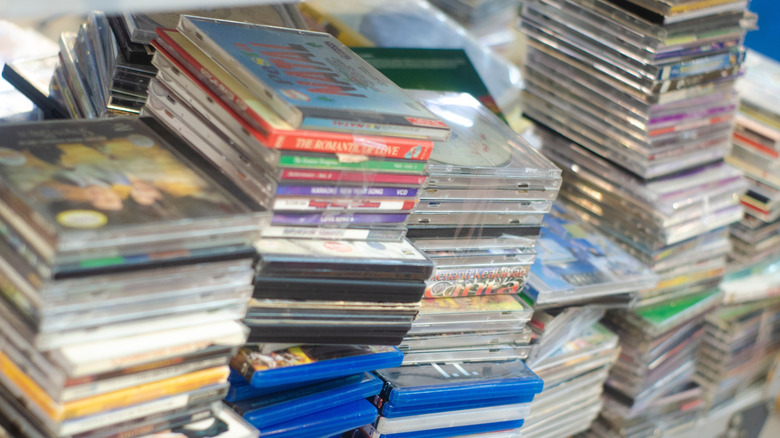Compact discs, or CDs, were revolutionary when they first emerged as a new medium for listening to music in the 1980s. Part of their success is alluded to in the name itself: the slim, compact size of CDs made them a popular replacement for bulky cassette tapes. Auto manufacturers quickly jumped on the craze by offering CD players in place of tape decks, and some new cars still offer CD players to this day. Yet, while CDs ushered consumers into the age of digital media, the music industry was scrambling to keep a hold onto the market reins.
Almost everything about CDs was uncharted territory. The benefits were obvious. Unlike analog audio formats, such as cassette tapes and vinyl records, a single CD can store and play about 80 minutes of clear high-fidelity audio. Even more novel, CDs contain digital files with coded information, such as track titles and timestamps, allowing users the ability to skip songs without needing to fast-forward or rewind the tape. The digital format of CDs also meant audio files could be easily transferred to other storage devices. For music executives, that’s where the troubles began.
CDs were invented in 1980 to store audio files, and the computer industry soon expanded the format’s compatibility with the CD-ROM. This gave consumers the opportunity not only to listen to a CD’s data but soon to write it as well. To the dismay of the music industry, pirated music spread like wildfire, since anyone with an original CD and a witeable CD drive could create digitally identical copies of an album. It was called “burning” a CD, and it was costing the music industry millions in potential sales. Once a used CD was saved to a personal computer, many people would simply sell the disc and keep the music.
How music listenership boomed while sales dropped in the 2000s
According to FIAA data compiled by the World Economic Forum, music industry profits peaked in 1999, with annual revenue exceeding 20 billion dollars. But rather than continue to rise or plateau into the new millennium, profits actually plummeted in the 2000s. The main culprit was piracy. The file-sharing platform Napster allowed people to download full-quality audio files for free as well as upload their own. Napster was shut down within two years of its rise, but it had already opened the floodgates to a new era of music.
Other file-sharing platforms took Napster’s place, and many people saw little reason to pay full price for a physical CD when they could just download an album and burn it to a blank CD for free. By 2007, music revenue had declined to roughly half of its 1999 peak, even as the industry was being bolstered by rising digital sales. Yet, while piracy was the main cause of the monumental drop in new CD sales, there was a legal market that was compounding the music industry’s losses: the used CD market.
The reselling of CDs was a major concern for the music industry several years before piracy became a problem. As far back as 1992, record company executives were condemning the increasing number of retailers turning towards the used CD market. The senior vice president of PolyGram Group called the sale of used CDs potentially “dangerous,” while talks of retaliation and restrictions on consumers buzzed throughout the industry. But despite all the talk, nothing could effectively be done to significantly curb the sale of used CDs because CDs don’t deteriorate with age. An undamaged used CD sounds just as good as a new one.
Why CDs can be resold over and over again
Record shops had been selling used media long before the invention of CDs. However, the sound quality of analog audio formats degrades over time. A vinyl record wears down with use, while dust and grime buildup can make the sound crackly and unclear. The delicate magnetic tape in cassettes deteriorates with age as well, leading to a distorted, muffled sound. Used vinyl records and cassettes were still sold, but buyers were often more willing to pay full price for the high-quality assurance of brand-new albums.
The digital files on a CD, however, sound just as good the first time they’re played as they do the thousandth time. Of course, damage to a CD can result in playback issues, and the heat and humidity exposure can cause something called “disc rot,” rendering the CD unreadable. But because CDs contain digital files, the quality of their audio doesn’t degrade over time. As long as a CD player can read the digital files stored on the CD, sound quality is dependent on the audio hardware used for playback — not the age of the CD.
A product that could be reused indefinitely was undoubtedly a daunting concept for music industry execs. Their outrage came during a time of record profits, so little was done to curb the resale of used CDs. By the 2010s, physical media was on the way out, and the market shifted towards music streaming and digital sales. Curiously, vinyl has been making a comeback in recent years, even outselling CDs. If the trend continues, we may see history repeat itself with the return of the used CD market.

